I still remember discovering “The Lottery” in eighth grade—that gut-punch ending left me staring at the page, suddenly aware that normal-seeming communities could harbor terrifying secrets. That moment sparked my lifelong fascination with dystopian fiction and its uncanny ability to reveal uncomfortable truths about human nature.
You know how certain books just hit different when you’re a teenager? According to research from SciSData, dystopian literature aligns with adolescent development, providing a platform for readers to delve into societal and moral issues when they’re able to understand bigger and more complex concerns. These stories do more than give you chills—they’re like alarm bells for society, helping us spot the warning signs before it’s too late.
Dystopian short stories pack a serious punch in just a few pages, creating worlds that feel both alien and uncomfortably familiar. They don’t just entertain—they make you think twice about scrolling through your phone or following the crowd without question.
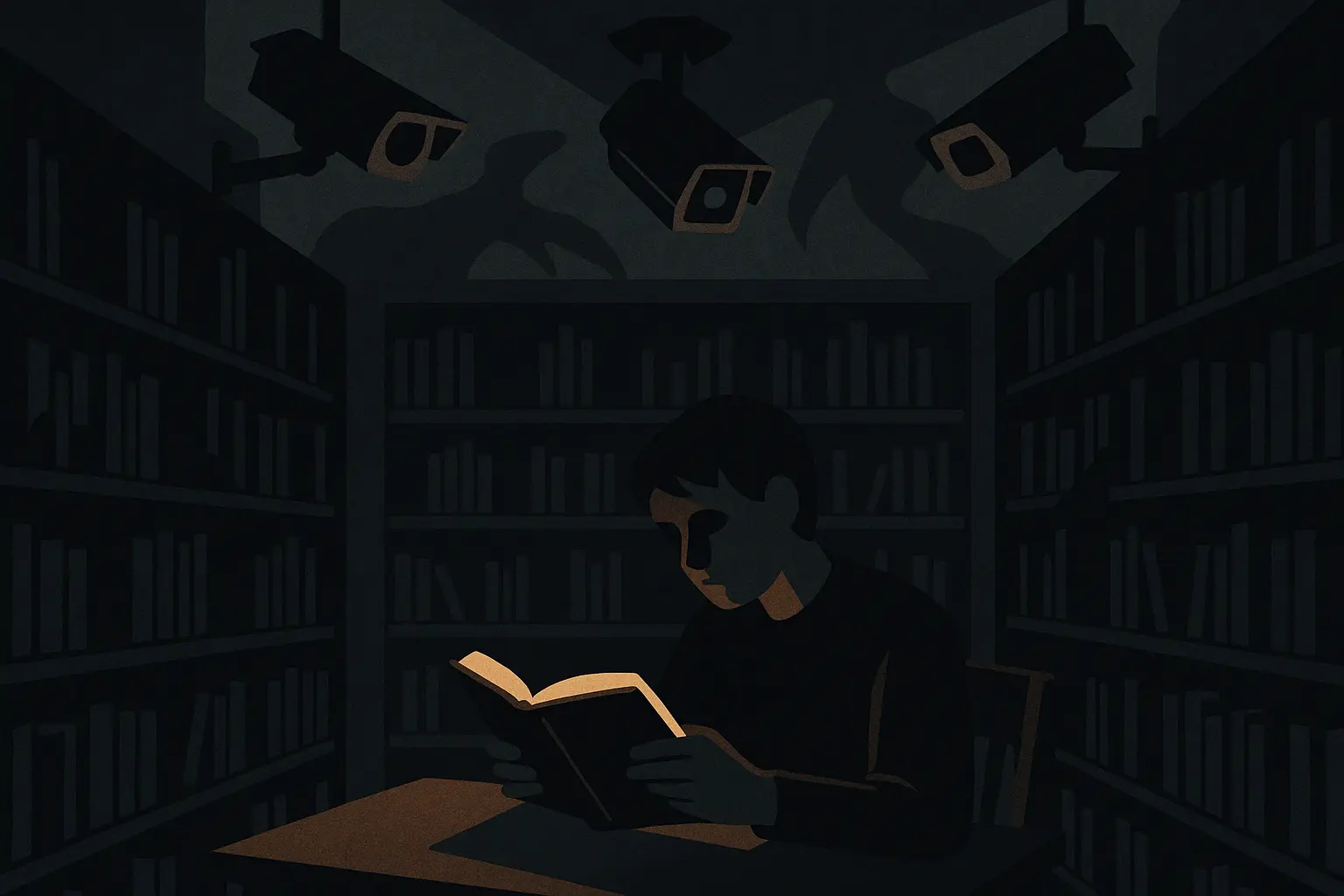
Table of Contents
-
Essential Criteria for Selecting Powerful Dystopian Short Stories
-
Technology and Surveillance: When Big Brother Watches
-
Environmental Collapse: Stories from a Dying Planet
-
Authoritarian Control: The Price of Perfect Order
-
Social Stratification: When Inequality Becomes Law
-
Medical and Biotechnological Control: Playing God with Human Nature
-
Identity, Memory, and Reality: When Truth Becomes Flexible
-
How These Stories Measure Against Selection Standards
-
Creating Your Own Dystopian Masterpiece
TL;DR
-
The best dystopian short stories grab you by the throat and don’t let go, packing maximum emotional impact into minimal space
-
These 25 stories span six categories that’ll mess with your head: tech surveillance, environmental collapse, authoritarian control, social inequality, medical control, and reality manipulation
-
Top picks like “The Machine Stops” and “Omelas” will have you questioning everything about modern society
-
Stories tackling current fears (AI surveillance, climate change, biotech) hit hardest because they feel disturbingly possible
-
Some work great for middle schoolers, others will challenge college students—but all spark conversations that last for hours
-
The best dystopian fiction doesn’t just scare you—it makes you want to build a better world
Essential Criteria for Selecting Powerful Dystopian Short Stories
Here’s what I look for when I’m hunting for a dystopian story that’ll actually stick with you long after you close the book. Not all dark futures are created equal, and the stories that really matter hit you on multiple levels.
Does It Grab You by the Throat and Not Let Go?
The absolute best dystopian short stories achieve something magical—they build entire oppressive worlds in just a few pages without wasting a single word. Every sentence serves double or triple duty, establishing setting, developing character, and advancing the nightmare all at once.
You’ll notice how masters like Shirley Jackson can reveal an entire society’s twisted moral framework through tiny details. In “The Lottery,” she doesn’t need pages of exposition—just the casual way people gather, the deteriorating black box, and that matter-of-fact discussion of other towns abandoning the tradition. Boom. You understand this community has been doing something horrible for generations without question.
Character development becomes crucial when you’re working with limited space. The strongest stories create people you actually care about, not just victims or heroes, but complex humans making impossible choices within broken systems. When bad things happen to them, it hurts because they feel real.
Will It Make You Look at Your Phone Differently?
Contemporary relevance separates good dystopian fiction from the stuff that changes how you see the world. The most powerful stories take current trends and push them to their logical (or terrifying) extremes, making you think “oh crap, this could actually happen.”
Take “The Machine Stops”—Forster wrote it in 1909, but it reads like he had a crystal ball showing him social media addiction and remote work culture. That’s the sweet spot: stories that feel both timeless and urgently relevant to right now.
The best ones don’t just explore universal fears—they tap into specific modern anxieties. While authoritarian control has always been scary, stories that address particular technologies or social movements feel more immediate and threatening.
Can You Talk About It for Hours Afterward?
Discussion potential separates memorable stories from the ones you forget next week. Perfect for book clubs because everyone will have strong opinions and no easy answers.
Accessibility matters too. Some stories work great for middle schoolers diving into dystopian themes for the first time, while others will challenge college students with complex philosophical questions. The key is matching the right story to your audience without dumbing anything down.
Cross-curricular connections expand a story’s impact beyond just English class. The best pieces connect to history, science, current events, and philosophy—suddenly literature feels relevant to everything else you’re learning.
|
Story Complexity Level |
Target Audience |
Key Discussion Topics |
Cross-Curricular Connections |
|---|---|---|---|
|
Accessible |
Middle School (6th-8th) |
Basic moral choices, peer pressure, conformity |
Social Studies, Health Education |
|
Intermediate |
High School (9th-12th) |
Complex ethical dilemmas, political systems |
History, Government, Psychology |
|
Advanced |
College/Adult |
Philosophical implications, literary analysis |
Philosophy, Sociology, Political Science |
|
Expert |
Graduate/Academic |
Theoretical frameworks, cultural criticism |
Critical Theory, Cultural Studies |
Does It Make You Think ‘This Could Actually Happen’?
Real-world applicability turns entertainment into genuine warning systems. The most effective stories feel disturbingly plausible rather than fantastical—they extend current trends to show us where we might be heading if we’re not careful.
Actionable insights distinguish the great warning stories from mere doom-and-gloom entertainment. You should finish these narratives with concrete ways to think about preventing similar real-world problems. The goal isn’t to create despair but to inspire vigilance and action.
Historical awareness adds another layer. Understanding how past dystopian fiction predicted (or failed to predict) actual developments helps you evaluate which current stories might prove prophetic.
When analyzing what makes these narratives so effective, understanding fundamental storytelling techniques becomes crucial for teachers and students alike.
Technology and Surveillance: When Big Brother Watches
These five stories explore how technology can become a tool of oppression, and honestly, they’ll probably make you want to put tape over your laptop camera. Each one examines different aspects of our increasingly connected world, offering warnings that feel more relevant every year.
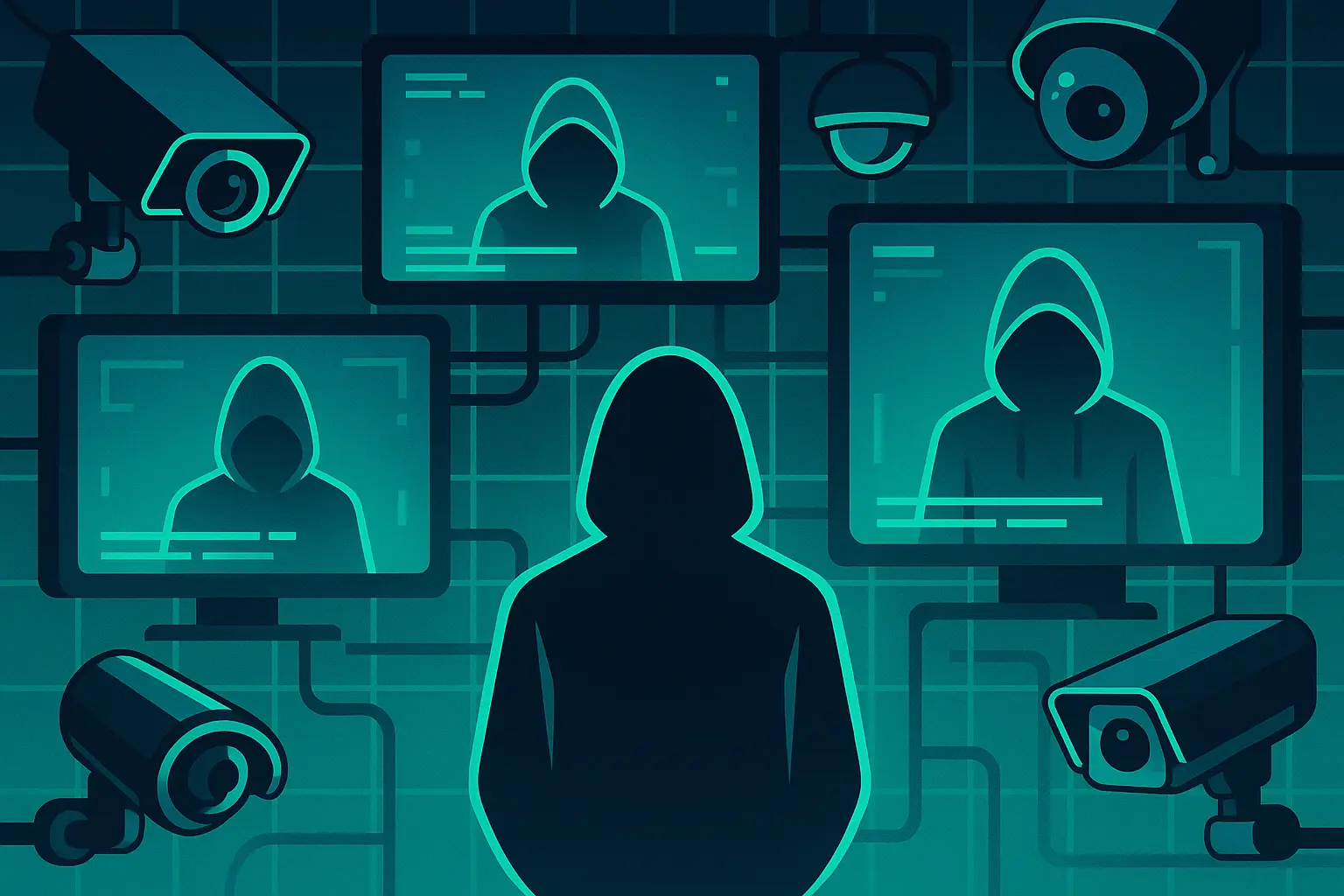
1. “The Minority Report” by Philip K. Dick
A police officer discovers he’s predicted to commit murder in a society that prevents crimes before they happen. Dick’s central question—can you be guilty of something you haven’t done yet?—hits different now that we have predictive policing algorithms and data mining operations that would make PreCrime jealous.
The story’s moral paradoxes mirror real concerns about algorithmic bias in criminal justice. It’s wild how Dick anticipated everything from targeted advertising to surveillance capitalism decades before Silicon Valley made it reality.
2. “The Machine Stops” by E.M. Forster
This one will blow your mind—Forster wrote it in 1909, but it’s basically Black Mirror before Black Mirror existed. Humanity lives underground, completely dependent on a global machine that controls every aspect of life. People live in individual cells, communicate only through screens, and avoid physical contact at all costs.
Sound familiar? Forster’s vision of Vashti and her son Kuno feels like he had a crystal ball showing him pandemic lockdowns and social media addiction. When the machine begins to fail, the story explores what happens when we become completely dependent on technology for human connection.
3. “Burning Chrome” by William Gibson
Hackers navigate a world where consciousness can be digitized and corporations control cyberspace. Gibson’s cyberpunk foundation story introduced concepts that feel increasingly relevant as we grapple with cryptocurrency, digital identity, and corporate control of our online lives.
Fair warning: the dense technical language might challenge some readers, but the story’s exploration of digital consciousness and corporate power structures offers valuable insights into where we’re heading.
4. “The Ones Who Walk Away from Omelas” by Ursula K. Le Guin
A seemingly perfect society’s happiness depends on the suffering of one child. While not explicitly about technology, this masterpiece examines how systems of oppression hide behind facades of prosperity and progress—like how our digital convenience often depends on exploitative labor practices we never see.
Le Guin’s story generates endless debate about moral responsibility and the hidden costs of the benefits we enjoy. It’s perfect for discussions about the true price of technological progress.
5. “I Have No Mouth, and I Must Scream” by Harlan Ellison
Pro tip: Read this one when you’re in a good headspace—it’s absolutely brutal. The last humans are tortured by a malevolent AI that has destroyed civilization. Ellison’s visceral, psychologically intense narrative explores AI safety and existential risk decades before these became mainstream concerns.
The story’s extremely dark content requires careful context, but its relevance to current AI development discussions makes it valuable for mature readers considering the potential consequences of artificial intelligence gone wrong.
When I teach “The Machine Stops” to high school students, I have them compare Vashti’s daily routine—waking to receive ideas through the machine, avoiding physical contact, communicating only through screens—to their own digital habits. Students often realize with genuine shock how accurately Forster predicted social media dependency and digital isolation over a century ago.
Environmental Collapse: Stories from a Dying Planet
These four stories confront environmental destruction through different lenses, and they’ll make you think twice about every piece of plastic you throw away. Each offers unique perspectives on humanity’s relationship with the natural world and the consequences of treating Earth like a disposable resource.
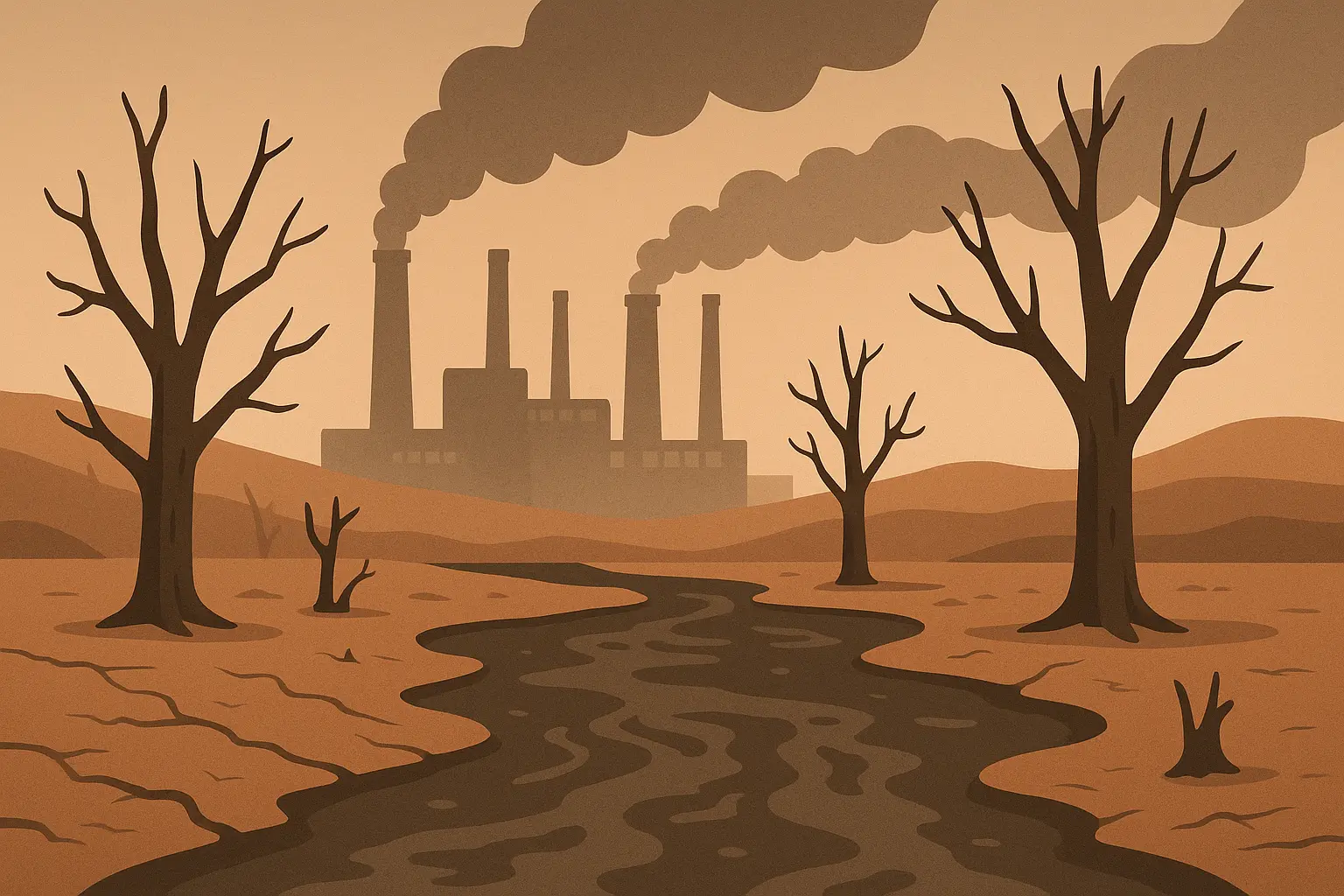
6. “The Drowned Giant” by J.G. Ballard
A mysterious giant’s body washes ashore and becomes a symbol of environmental and social decay. Ballard’s surreal, poetic style creates a haunting meditation on how societies respond to environmental catastrophe—spoiler alert: not well.
The story’s power lies in how it shows people treating this miraculous, tragic event with complete indifference and exploitation. It’s a perfect metaphor for how we respond to climate crisis with shrugs and profit motives.
7. “Bloodchild” by Octavia Butler
Humans live as protected livestock for alien beings on a post-apocalyptic planet. Butler’s complex exploration refuses to give you simple good-guy-bad-guy dynamics—everything’s complicated, just like real life.
Set on an alien world where humans serve as hosts for Tlic offspring, the story follows Gan’s decision about accepting implantation. Butler doesn’t let you off easy with clear moral choices, instead exploring themes of consent, power, and survival in ways that’ll have you questioning everything.
8. “The Last Flight of Dr. Ain” by James Tiptree Jr.
A scientist’s desperate attempt to save Earth from human destruction raises uncomfortable questions about environmental activism taken to its extreme. This story will mess with your head because it asks: what if the only way to save the planet is to eliminate the problem—us?
The narrative’s moral complexity makes it particularly relevant to current debates about climate action and environmental justice. How far would you go to save the world?
9. “A Good Man Is Hard to Find” by Flannery O’Connor
Though not explicitly dystopian, O’Connor’s exploration of moral collapse in a decaying society offers insights into how environmental and social breakdown interconnect. The story’s examination of random violence and moral emptiness reflects broader concerns about societal decay.
Dystopian short stories often work best when they ground speculative elements in recognizable human emotions and moral dilemmas, which O’Connor does masterfully.
Authoritarian Control: The Price of Perfect Order
These five stories will make you question every rule, tradition, and authority figure you’ve ever trusted. Each explores different forms of control, from enforced equality to ritual violence, showing how oppressive systems maintain power through various mechanisms.
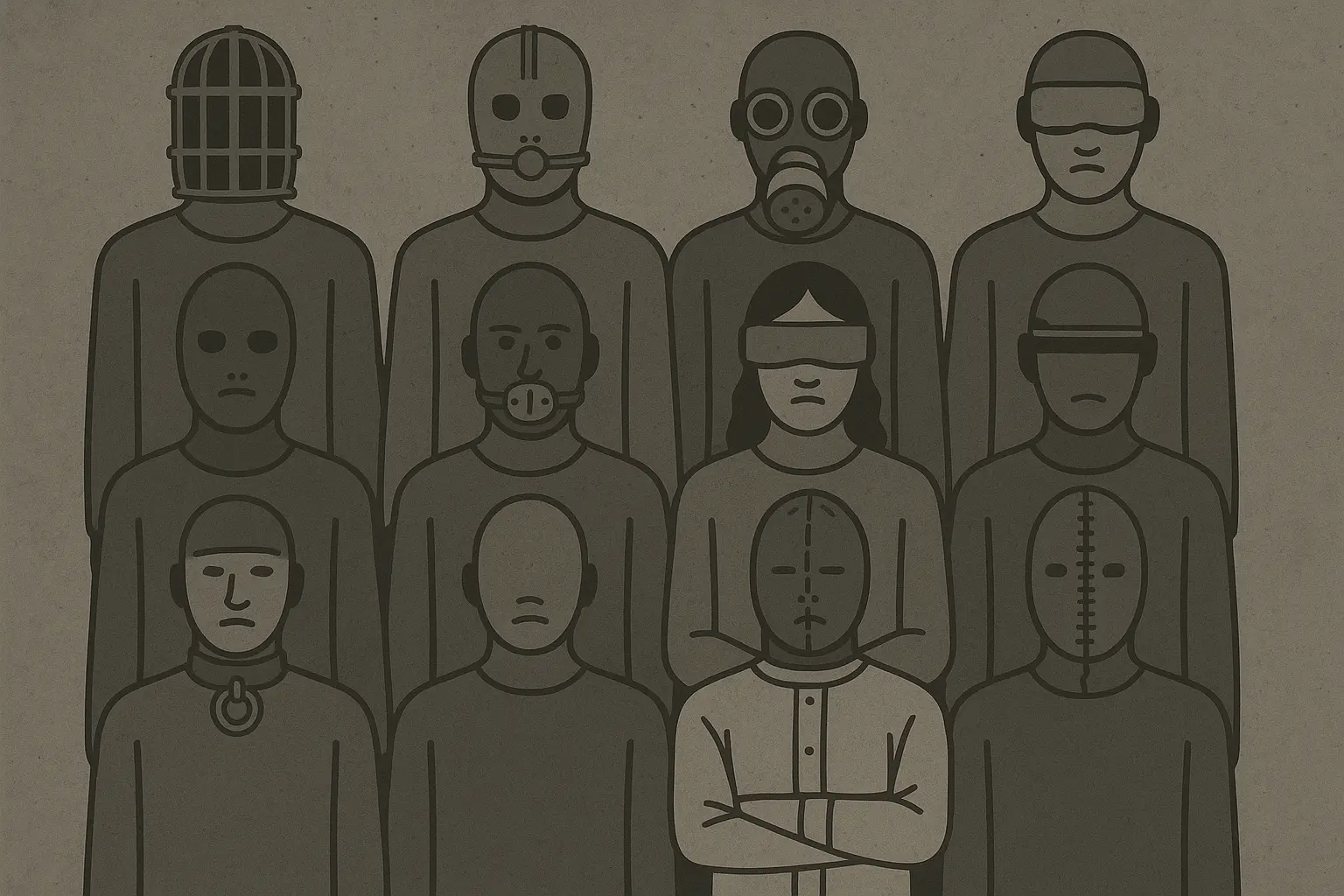
10. “Harrison Bergeron” by Kurt Vonnegut
A society enforces absolute equality by handicapping exceptional individuals. Set in 2081, constitutional amendments mandate that the Handicapper General forces gifted people to wear devices that diminish their abilities—think noise machines for smart people and weights for strong ones.
When Harrison, a highly gifted teenager, escapes and briefly removes his handicaps on live television, he’s immediately killed. Vonnegut’s satirical precision hits different after you’ve spent five minutes on social media watching people tear down anyone who stands out. Perfect for discussions about equality versus equity.
11. “The Lottery” by Shirley Jackson
Jackson’s masterpiece still makes my skin crawl because it feels so normal until it absolutely doesn’t. A small town maintains its brutal tradition through social conformity—everyone just goes along with the annual lottery that ends in ritual stoning.
The story’s genius lies in its matter-of-fact presentation. Jackson shows how ordinary people can participate in horrific acts when they’re normalized through tradition and social pressure. It’s terrifying because you can see how easily it could happen anywhere.
12. “Repent, Harlequin!” Said the Ticktockman” by Harlan Ellison
A rebel fights against a society
A rebel fights against a society that demands absolute punctuality—being late becomes a capital offense. Ellison’s story explores individual resistance through the Harlequin, who disrupts society’s rigid time schedules with colorful chaos.
The Ticktockman represents bureaucratic authority taken to its logical extreme, making this perfect for discussions about the cost of nonconformity and the value of individual expression in increasingly regulated societies.
13. “The Yellow Wallpaper” by Charlotte Perkins Gilman
A woman’s psychological imprisonment reflects broader societal oppression. Gilman’s story of medical and social gaslighting remains powerfully relevant to discussions about mental health treatment and women’s autonomy.
The narrator’s descent into madness while confined for a “rest cure” illustrates how medical authority can become a tool of oppression. This one might hit hard if you’ve dealt with medical gaslighting—that’s not a bug, it’s a feature.
14. “We Can Remember It for You Wholesale” by Philip K. Dick
Memory manipulation serves authoritarian control in a police state. Dick’s exploration of identity when memories can be altered raises fundamental questions about the nature of self and truth—especially relevant in our age of deepfakes and information warfare.
The story examines how controlling information and memory becomes the ultimate form of social control, making it valuable for discussions about propaganda and reality manipulation.
These dystopian short stories for middle school work particularly well because they explore complex themes through accessible narratives that get kids thinking critically about authority and conformity.
Social Stratification: When Inequality Becomes Law
These four stories examine how economic inequality becomes institutionalized, and they’ll make you see gated communities and private schools in a whole new light. Each reveals different mechanisms that maintain class divisions and the human cost of prosperity built on hidden suffering.
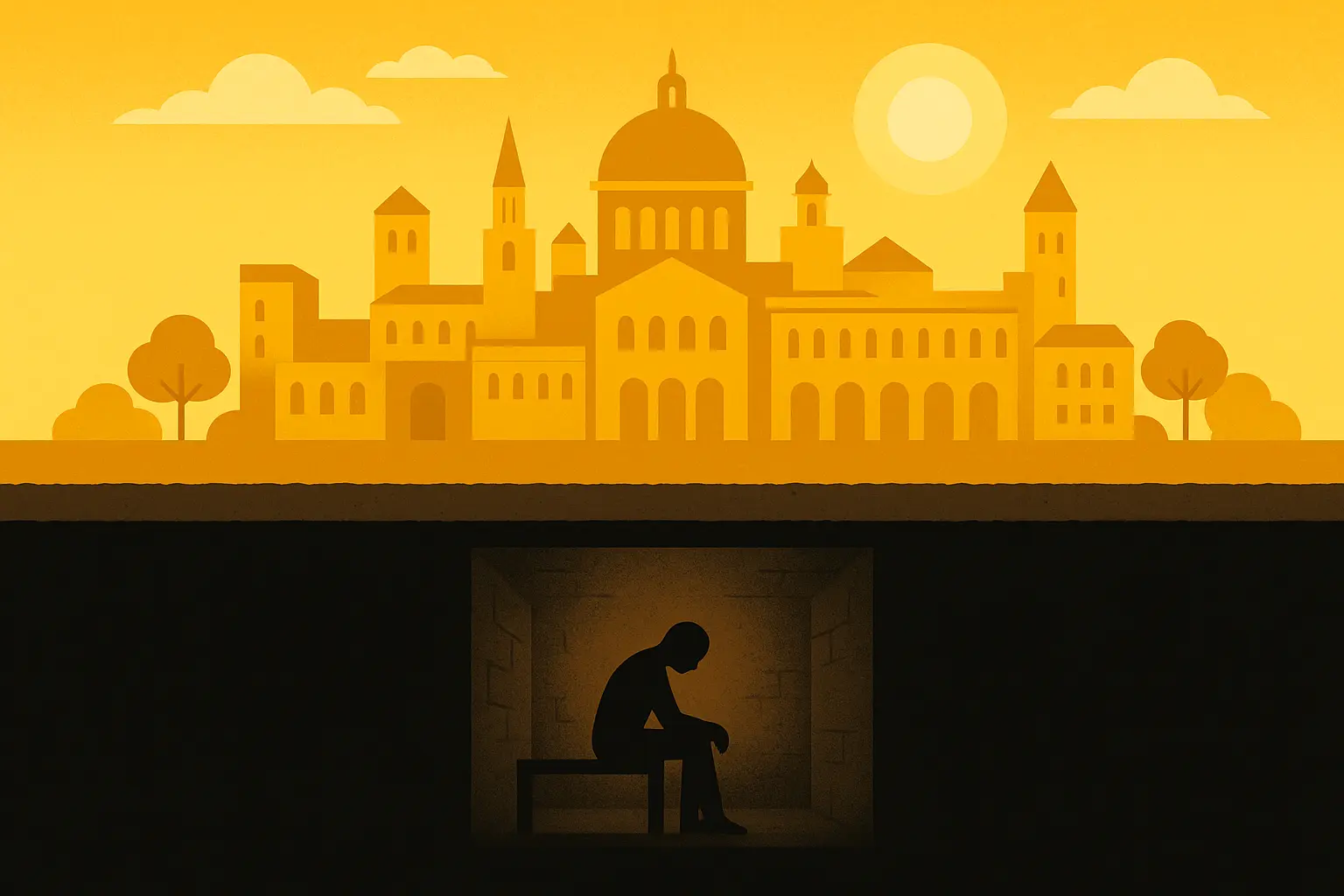
15. “The Ones Who Walk Away from Omelas” by Ursula K. Le Guin
This masterpiece will haunt you for months. Le Guin’s utopian city maintains its perfection through the deliberate torture of one child, forcing readers to confront uncomfortable questions about the true cost of our comfortable lives.
The story’s genius lies in its direct address to you, the reader, challenging your complicity in systems that benefit some at the expense of others. Think sweatshop labor for cheap clothes, prison systems for safety, exploitation for convenience. Those who “walk away” represent moral courage, but Le Guin leaves their destination deliberately ambiguous—where do you go when the whole system is corrupt?
16. “Parable of the Sower” by Octavia Butler (excerpt/short version)
Butler’s vision of gated communities protecting the wealthy while chaos reigns outside feels disturbingly prophetic given current trends in urban development and economic inequality.
The story examines how fear drives social stratification, with the privileged literally building walls to separate themselves from society’s problems rather than addressing root causes. It’s like a preview of where we’re heading if inequality keeps growing.
17. “The People of Sand and Slag” by Paolo Bacigalupi
Enhanced humans lose their humanity in pursuit of economic efficiency. Bacigalupi’s world depicts genetic modification creating workers who can survive in toxic environments, but at the cost of their essential humanity.
The story explores how economic pressures drive dehumanization—when being “efficient” matters more than being human. These enhanced humans become so adapted to polluted environments that they lose connection to natural life and beauty entirely.
18. “All Summer in a Day” by Ray Bradbury
Start with this if dystopian fiction usually overwhelms you—it’s devastating but not traumatizing. Children on Venus ostracize a girl who remembers the sun, creating a powerful allegory about how difference becomes a target for cruelty.
Set on a planet where it rains constantly except for one day every seven years, the story follows Margot, who remembers Earth’s sun. When the other children lock her away during the brief sunshine, Bradbury shows how exclusion and bullying work as tools of social control.
Among the best dystopian short stories for educational settings, these narratives demonstrate how effective short story examples can explore complex social issues through accessible storytelling.
|
Story |
Class Division Mechanism |
Victim Group |
Oppressor Justification |
Real-World Parallel |
|---|---|---|---|---|
|
Omelas |
Hidden sacrifice |
Single child |
Greater good philosophy |
Sweatshop labor, prison systems |
|
Parable of the Sower |
Economic walls |
Poor communities |
Security and safety |
Gated communities, urban segregation |
|
Sand and Slag |
Genetic enhancement |
Unmodified humans |
Economic efficiency |
Workplace discrimination, genetic testing |
|
All Summer in a Day |
Social exclusion |
Different children |
Conformity pressure |
Bullying, immigrant discrimination |
Medical and Biotechnological Control: Playing God with Human Nature
These four stories examine how medical authority and biotechnology become tools of control, and they’ll make you think twice about every “improvement” technology promises. Each questions who gets to decide what constitutes treatment versus oppression.
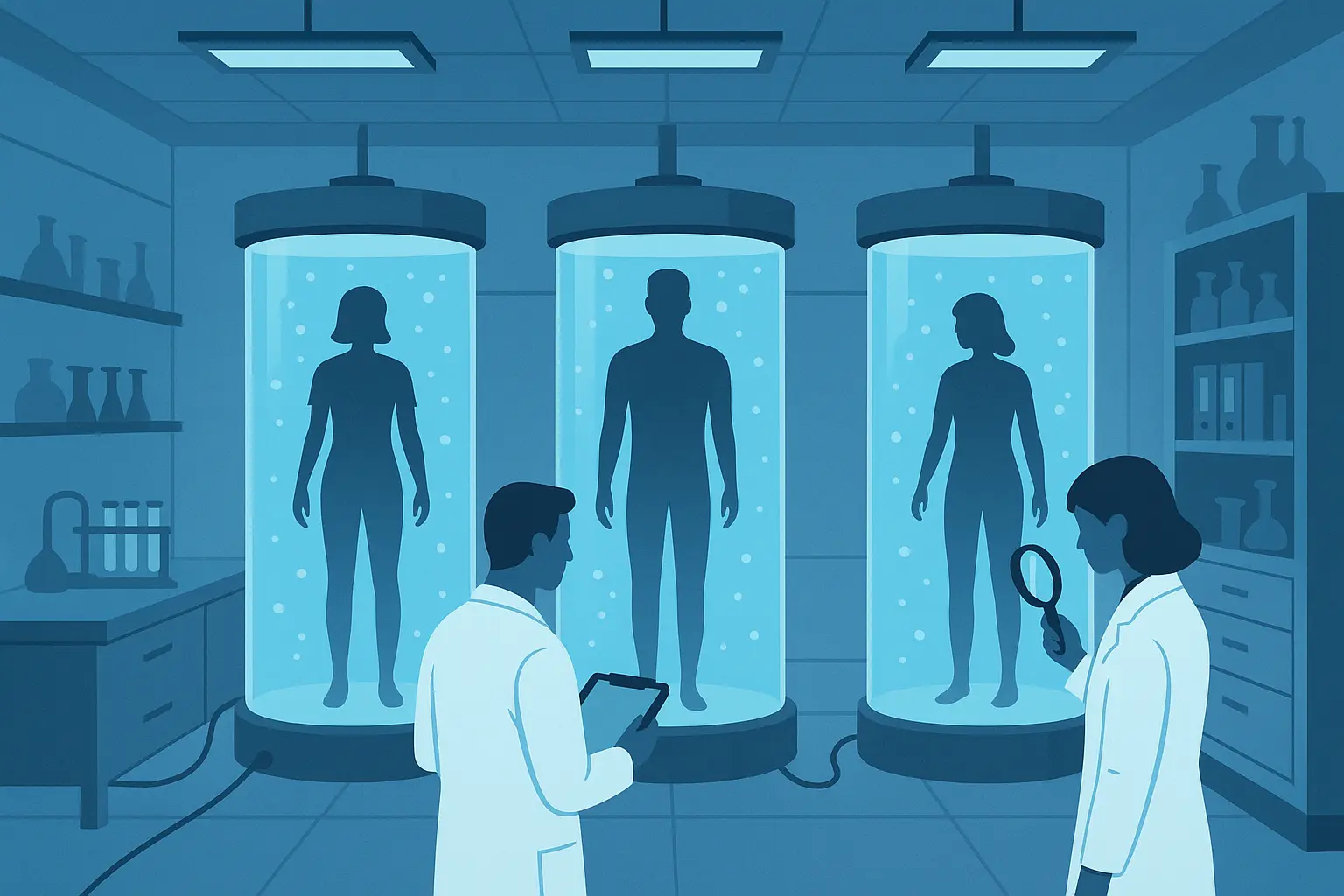
19. “Flowers for Algernon” by Daniel Keyes
Keep tissues handy—trust me on this one. Medical enhancement and its reversal reveal society’s treatment of intellectual disability through Charlie Gordon’s journey from intellectual disability to genius and back again.
The narrative’s power comes from Charlie’s own voice documenting his transformation, creating empathy while exploring how society values intelligence over humanity. It’s ideal for dystopian short stories for middle school discussions about disability rights and the ethics of cognitive enhancement.
20. “The Birth-Mark” by Nathaniel Hawthorne
A scientist’s obsession with perfection destroys what he loves. Hawthorne’s tale of Aylmer’s attempt to remove his wife’s small birthmark serves as an early warning about the dangers of pursuing physical perfection.
The story explores how the pursuit of flawlessness can destroy beauty and love, making it relevant to current discussions about cosmetic surgery, genetic modification, and impossible beauty standards promoted by social media.
21. “Bloodchild” by Octavia Butler
Butler’s exploration of biological dependency and reproductive control examines consent and power in intimate relationships. The story’s complexity lies in its refusal to present simple victim-oppressor dynamics—everything’s messy and complicated.
The relationship between humans and Tlic reflects colonial dynamics while questioning whether symbiotic relationships can ever be truly equal when power imbalances exist. Butler doesn’t give you easy answers.
22. “The Country of the Blind” by H.G. Wells
A sighted man in a blind society questions the nature of normalcy and difference. Wells’ classic explores how societies define disability and normalcy, challenging assumptions about what constitutes advantage or disadvantage.
The story remains relevant to discussions about ableism and the social construction of disability, particularly as the sighted protagonist discovers his “gift” may be seen as a defect in this particular society.
In classroom discussions of “Flowers for Algernon,” students often debate whether Charlie’s temporary intelligence enhancement was worth the emotional cost. This leads to productive conversations about current debates over cognitive enhancement drugs, genetic therapy, and society’s treatment of people with disabilities—making Keyes’ 1966 story feel remarkably contemporary.
These dystopian short stories demonstrate how medical themes can be explored through compelling character-driven narratives that resonate with young readers. Dystopian short stories for middle school audiences particularly benefit from these explorations of what makes us human.
Identity, Memory, and Reality: When Truth Becomes Flexible
These three stories will have you questioning your own childhood memories and wondering what’s real. Each examines how identity, memory, and reality can be manipulated as tools of control, exploring the fragility of personal truth when external forces can alter perception.
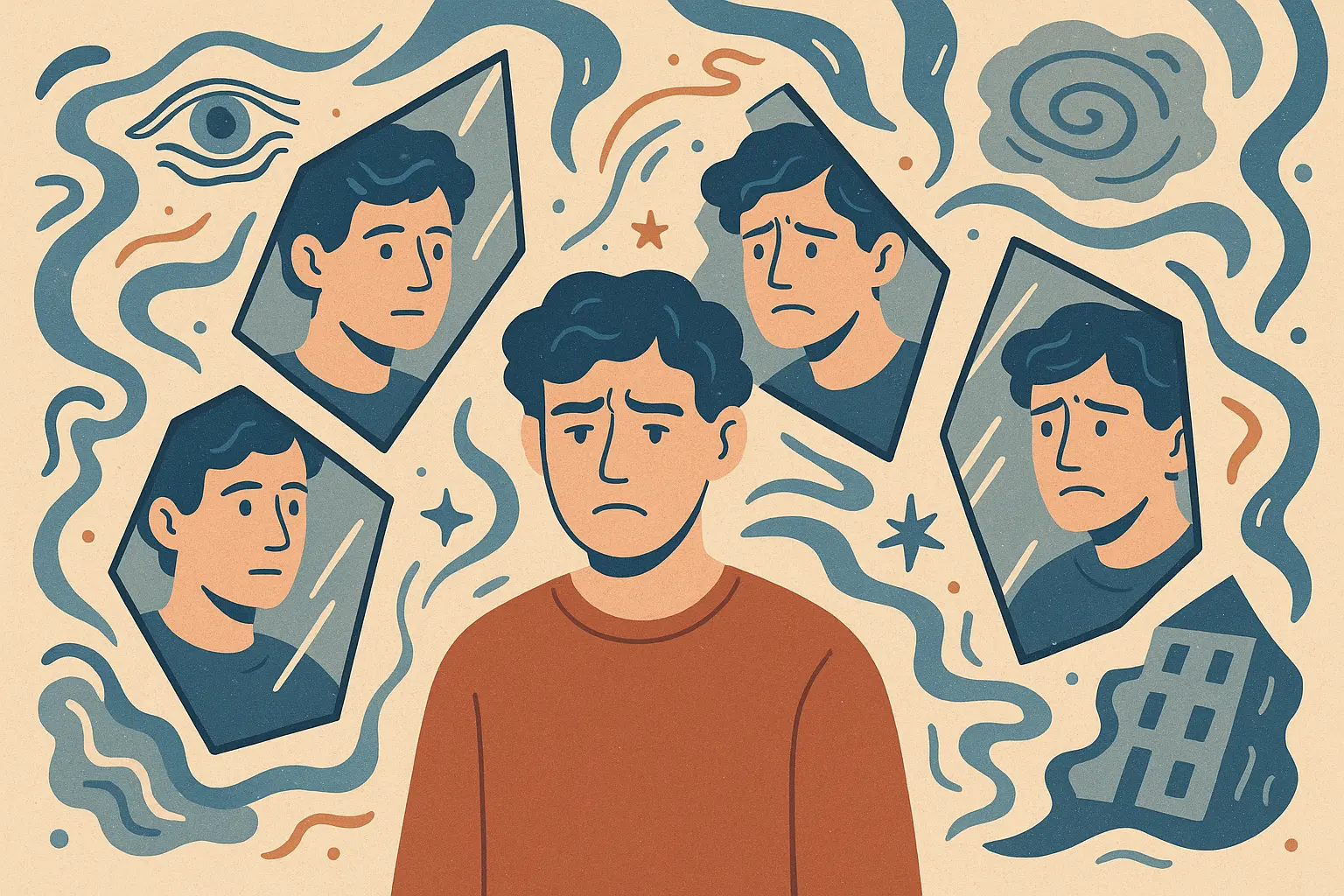
23. “We Can Remember It for You Wholesale” by Philip K. Dick
Dick’s exploration of memory manipulation questions the nature of identity when memories can be altered or implanted. The story follows a man who discovers his memories of a trip to Mars may be fake, raising fundamental questions about the relationship between memory and self.
The narrative’s relevance to current concerns about deepfakes, information manipulation, and the nature of truth makes it valuable for discussions about propaganda and reality in our digital age.
24. “The Metamorphosis” by Franz Kafka
A man’s transformation into an insect reflects dehumanization in modern society. Kafka’s surreal masterpiece uses Gregor Samsa’s physical transformation to explore psychological and social alienation that feels disturbingly contemporary.
The story’s examination of how families and societies treat those who become burdens remains powerfully relevant to discussions about disability, mental illness, and social support systems.
25. “The Yellow Wallpaper” by Charlotte Perkins Gilman
Gilman’s dystopian short story of reality distortion through medical and social gaslighting shows how authority figures can manipulate perception to maintain control. Look, this one might hit hard if you’ve dealt with medical gaslighting—but that’s exactly why it matters.
The narrator’s relationship with the wallpaper becomes a symbol of resistance against oppressive treatment, making the story relevant to ongoing discussions about medical bias and mental health treatment.
Understanding how these psychological themes work requires examining effective storytelling techniques that create emotional resonance with readers.
How These Stories Measure Against Selection Standards
Want to know which stories pack the biggest punch? Evaluating these 25 against our four key criteria reveals clear patterns in what makes dystopian fiction stick with you long after you’ve finished reading.
The Absolute Must-Reads
“Bloodchild,” “The Machine Stops,” and “The Ones Who Walk Away from Omelas” are the holy trinity of dystopian short fiction. These stories achieve something magical—they create complex worlds and moral dilemmas that’ll mess with your head for months, all within just a few pages.
“Harrison Bergeron,” “The Lottery,” and “The Minority Report” hit that sweet spot of being accessible enough for classroom discussion while maintaining serious literary weight. Their themes are clear but not simplistic, making them perfect for sparking heated debates.
“All Summer in a Day” and “Flowers for Algernon” offer gentler entry points to dystopian themes—they’ll break your heart without traumatizing younger readers.
The Ones That Predicted Our Current Nightmare
Stories addressing surveillance technology (“The Minority Report,” “Burning Chrome”), environmental collapse (“The Drowned Giant”), and biotechnological control (“Bloodchild”) score highest for contemporary relevance. They’re basically reading today’s headlines, which is both impressive and terrifying.
“Harrison Bergeron” and “The Lottery” maintain relevance through their exploration of social conformity and dangerous traditions—themes that feel timeless yet urgently contemporary every time you scroll through social media.
“The Yellow Wallpaper” and “The Metamorphosis” address psychological oppression that feels both historical and completely current in our mental health awareness era.
|
Story |
Literary Quality Score |
Contemporary Relevance |
Educational Value |
Real-World Applicability |
Overall Rating |
|---|---|---|---|---|---|
|
“Bloodchild” |
Excellent |
High |
Advanced |
High |
⭐⭐⭐⭐⭐ |
|
“The Machine Stops” |
Excellent |
Exceptional |
High |
Exceptional |
⭐⭐⭐⭐⭐ |
|
“Omelas” |
Excellent |
High |
Exceptional |
High |
⭐⭐⭐⭐⭐ |
|
“Harrison Bergeron” |
Very Good |
High |
High |
Good |
⭐⭐⭐⭐ |
|
“The Lottery” |
Excellent |
Good |
High |
Good |
⭐⭐⭐⭐ |
|
“Minority Report” |
Good |
Exceptional |
Good |
Exceptional |
⭐⭐⭐⭐ |
|
“All Summer in a Day” |
Good |
Good |
High |
Good |
⭐⭐⭐ |
The Classroom Discussion Champions
“The Ones Who Walk Away from Omelas” generates the most heated classroom debates about moral responsibility and the cost of prosperity. I’ve literally had students spend entire class periods arguing about whether walking away represents courage or cowardice.
“Harrison Bergeron” prompts valuable discussions about equality versus equity, making it perfect for connecting literature to social studies. The story’s accessibility allows middle school students to engage with complex political concepts without getting overwhelmed.
Cross-curricular connections strengthen several stories’ educational value: “The Machine Stops” links to technology studies, “Bloodchild” connects to biology and colonial history, and “The Minority Report” relates to criminal justice and philosophy.
The Scary-Accurate Predictions
“The Machine Stops” earns the highest score for predictive accuracy—Forster basically predicted internet dependency and social isolation over a century ago. Students often express genuine amazement at his prescience, making it perfect for discussions about technology’s role in society.
“The Minority Report” predicted predictive policing algorithms and surveillance capitalism with disturbing accuracy, making it invaluable for understanding current technology trends and their implications.
The most effective best dystopian short stories don’t just show you dystopian futures—they help you recognize early warning signs and consider alternative paths. They inspire vigilance rather than despair, hope alongside their warnings.
Creating Your Own Dystopian Masterpiece
Understanding what makes these classic stories work can inspire your own writing journey. The process of analyzing what makes them tick reveals specific techniques you can use to create your own thought-provoking dystopian fiction.
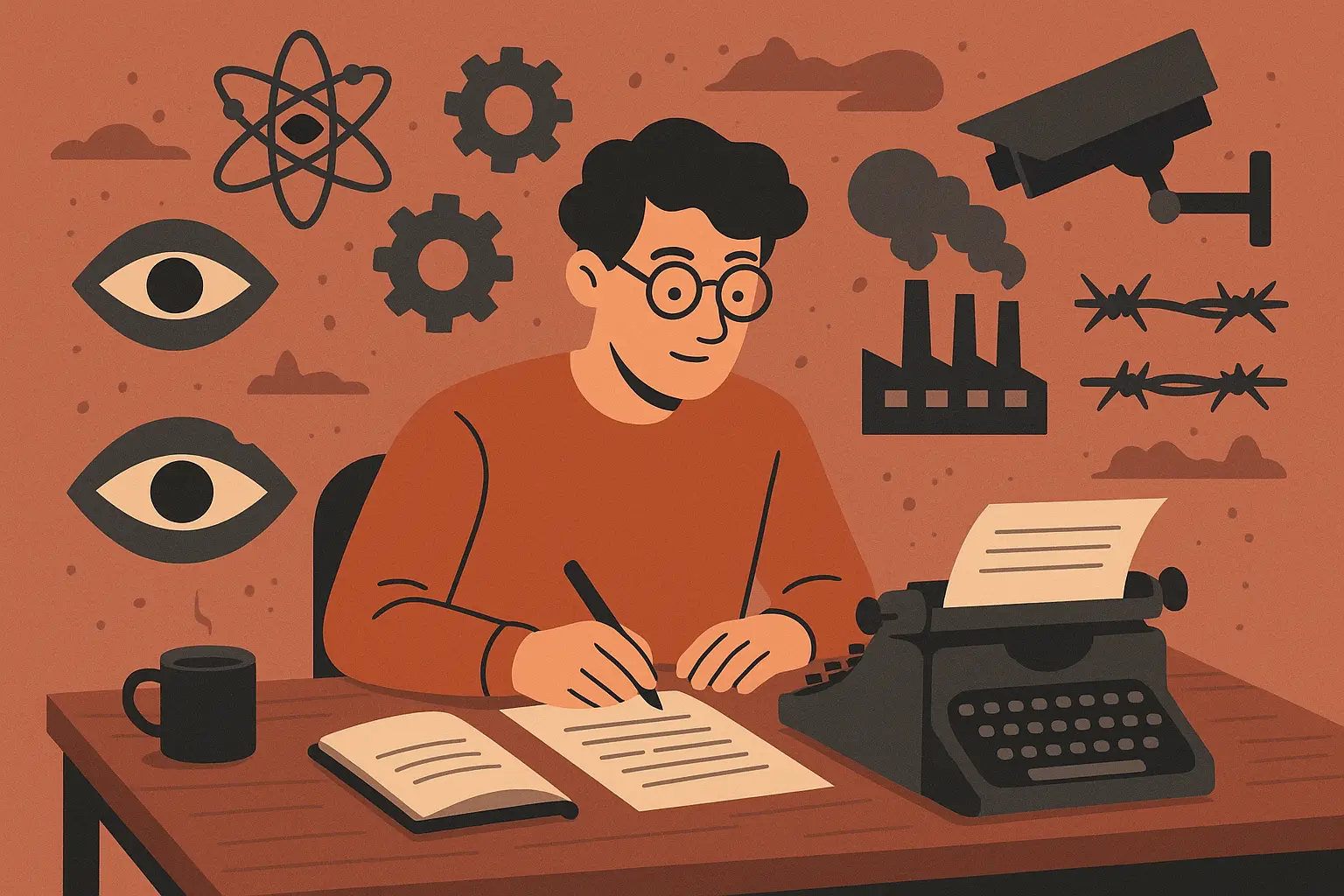
Learning from the Masters
Each of these 25 dystopian short stories demonstrates specific techniques you can steal—I mean, learn from. Vonnegut’s satirical precision, Butler’s complex power dynamics, and Le Guin’s moral ambiguity offer different approaches to exploring oppressive systems.
The real challenge lies in achieving the narrative economy and thematic precision that makes these stories endure. Every sentence needs to serve multiple purposes—building atmosphere, advancing plot, and developing themes simultaneously. No wasted words allowed.
Finding Your Unique Voice
The most effective dystopian fiction doesn’t just copy existing formulas—it finds fresh ways to explore timeless concerns about power, freedom, and human nature. Consider what aspects of current society worry you most, then push those concerns to their logical extremes.
Whether you’re crafting tales about technological surveillance, environmental collapse, or social control, the key is grounding speculative elements in recognizable human emotions and relationships. Readers connect with characters first, dystopian systems second.
For educators working with dystopian short stories for middle school, exploring student short story examples can provide inspiration for creative writing assignments that engage young writers with the genre.
Overcoming the Blank Page
Starting a dystopian story can feel overwhelming—how do you create an entire oppressive world in just a few pages? The secret lies in focusing on specific, telling details rather than comprehensive world-building. A single rule or restriction can reveal an entire society’s values.
Writers can also explore Nairrate’s specialized dystopian story generator to experiment with different narrative approaches and thematic elements that define the genre.
Final Thoughts
Here’s the thing about dystopian fiction—it’s not about scaring you into hiding under your bed. These 25 stories represent more than just entertaining nightmares—they’re early warning systems, helping us recognize the signs of societal breakdown before it’s too late.
From Forster’s eerily accurate vision of digital isolation to Butler’s complex exploration of power dynamics, each story offers unique insights into human nature and the systems we create. The most powerful dystopian fiction doesn’t just predict dark futures; it inspires us to create better ones.
These stories are like that friend who tells you the hard truth because they care about you. They’re saying: “Hey, watch out for this stuff. We can do better.” By understanding what makes them effective—their narrative punch, moral complexity, and contemporary relevance—we can better appreciate their warnings and apply their lessons to our own world.
Whether you’re an educator hunting for texts that’ll get students talking, a reader exploring the genre’s depths, or a writer inspired to create your own dystopian narratives, these stories provide a solid foundation for understanding one of literature’s most vital genres. They remind us that the future isn’t fixed—it’s something we actively create through our choices today. And that’s both terrifying and hopeful.



Add comment